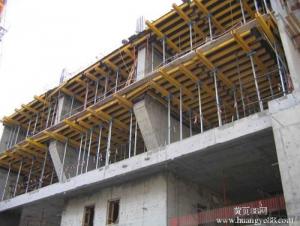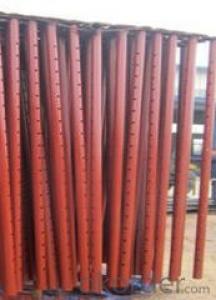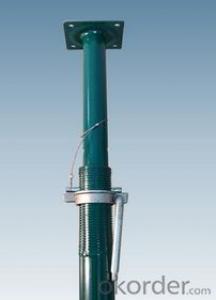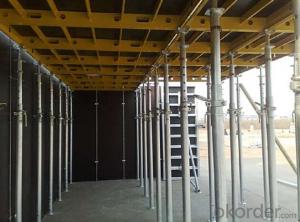Export Scaffold props / telescopic steel prop / blue color prop 2.2-4M/thickness 2.5mm
- Loading Port:
- China Main Port
- Payment Terms:
- TT or LC
- Min Order Qty:
- 1680 Piece/Pieces 1680pcs / 20'FT container pc
- Supply Capability:
- 10000 pc/month
OKorder Service Pledge
OKorder Financial Service
You Might Also Like
1. Length 2200-4000mm
2. Outer tube diameter 56mm
3. Inner tube diameter 48mm
4. Tube material : Q235
5. Tube thickness : 2.5mm
6. weight : 12.9kgs
7. square plate : 120*120*4mm
8. Italian type nut
9. G-pin 12
10. Painted surface
11. Color : as customer 's request . red / blue / green / orange/ brown
Packaging & Delivery
| Packaging Details: | packaging :50pcs / bale container : 1680pcs / 20ft |
|---|---|
| Delivery Detail: | 20-30days after receive deposit |
Specifications
Adjustable props / construction prop
Height 2.2-4M
Italy type painted props
Adjustable props
Shoring props
Construction scaffold steel prop
Scaffold props
Telescopic steel props



Product introduce
Steel Prop is a labour and time saving device to support shuttering and centering.
It is made outer tube of 60mm (O. D.) & inner pipe of 48mm (O. D.)
or outer tube 56mm (O.D.) & inner pipe 48mm (O.D.) ,
or outer tube 48mm (O.D.) & inner pipe 40 mm (O.D.) moving in each other telescopically.
The surface has painted , powder , electric galvanized and hot dipped galvanized .
The height use of props by double staging is recommended upto 7000mm only .
Top and bottom plate are provided with nail holes for wooden beam or steel beam .
The top has square shape , flower shape or U-head , U-fork head .
U-head can use fix or adjustable .
- Q: Can a steel prop be adjusted in height?
- Yes, a steel prop can be adjusted in height. Steel props, also known as adjustable steel props or steel acrow props, are commonly used in construction and renovation projects to support temporary structures or to provide additional support to existing structures. These props consist of a steel tube with an adjustable inner section, allowing the height to be easily adjusted to the desired level. The adjustable inner section is secured in place using a pin or a locking mechanism, ensuring stability and safety. This adjustability feature makes steel props highly versatile and adaptable to various construction requirements, allowing for easy installation and adjustment according to the specific needs of the project.
- Q: Can steel props be used in formwork systems?
- Yes, steel props can be used in formwork systems. Steel props are commonly used to support temporary structures and formwork systems during construction projects. They provide stability and strength to the formwork and can be easily adjusted to the desired height. Steel props are favored due to their durability and load-bearing capacity, making them suitable for various formwork applications.
- Q: How much is the triangle angle support window, bearing?
- It depends on how much you use thick tempered glass, are generally made of 12 mm tempered glass floor
- Q: What are the common load testing procedures for steel props?
- Some common load testing procedures for steel props include applying incremental weight loads to the prop and measuring deflection, conducting static load tests to assess the maximum load the prop can bear without failure, performing endurance tests to evaluate the prop's long-term durability under repeated loads, and conducting dynamic load tests to simulate real-world conditions and assess the prop's performance under varying loads.
- Q: How do you ensure stability when using steel props on uneven surfaces?
- To ensure stability when using steel props on uneven surfaces, it is important to follow these steps: 1. Start by ensuring that the steel props are properly adjusted to the correct height for the specific area or surface. 2. Use a spirit level or a similar tool to check the levelness of the steel props. Adjust the props accordingly to ensure they are perpendicular to the ground. 3. If the surface is extremely uneven or unstable, consider using additional supports such as wooden boards or wedges to provide extra stability and distribute the weight evenly. 4. Regularly inspect the steel props and the surrounding area to identify any signs of movement or instability. If any issues are detected, make necessary adjustments or reinforce the supports as needed. 5. Finally, it is crucial to follow the manufacturer's guidelines and safety instructions while using steel props to ensure stability and prevent any accidents or injuries.
- Q: Can steel props be used for supporting temporary walkways?
- Yes, steel props can be used for supporting temporary walkways. Steel props are commonly used in construction to provide temporary support for various structures, including walkways. They offer stability and strength, making them suitable for supporting temporary walkways and ensuring the safety of individuals using them.
- Q: How do steel props compare to scaffolding systems?
- Steel props and scaffolding systems are both commonly used in construction projects to provide support and stability. However, they differ in terms of their structure, versatility, and ease of use. Steel props, also known as acrow props, are adjustable telescopic steel tubes that can be extended or retracted to provide support for various structures. They are primarily used to support temporary structures such as formwork, walls, and beams. Steel props are easy to install and adjust, making them a popular choice for small to medium-sized projects. They are lightweight, portable, and can be easily transported to different locations. Additionally, steel props can be used individually or in combination with each other to create a stable support system. On the other hand, scaffolding systems are more complex structures consisting of frames, tubes, and platforms. They are typically used for larger construction projects that require a more extensive support system. Scaffolding systems provide a stable working platform for workers to access and work on different areas of a building or structure. They are versatile and can be customized to fit the specific requirements of a project. Scaffolding systems can be erected to various heights and configurations, allowing for a safe and efficient working environment. When comparing steel props to scaffolding systems, some key considerations include cost, speed of installation, versatility, and safety. Steel props are generally more cost-effective and quicker to install compared to scaffolding systems, making them a preferred choice for smaller projects with tight budgets and timelines. However, scaffolding systems offer greater versatility and can be adapted to various project requirements, especially for larger and more complex construction projects. In terms of safety, both steel props and scaffolding systems are designed to provide support and stability. However, scaffolding systems offer a more secure working platform with guardrails and handrails, ensuring the safety of workers at elevated heights. Steel props, on the other hand, may require additional safety measures such as scaffolding boards or platforms to create a stable working surface. In conclusion, while steel props and scaffolding systems serve similar purposes of providing support and stability in construction projects, they differ in terms of structure, versatility, ease of use, and safety features. The choice between steel props and scaffolding systems ultimately depends on the specific requirements and constraints of the project at hand.
- Q: Can steel props be used for supporting temporary roof structures?
- Yes, steel props can be used for supporting temporary roof structures. Steel props, also known as adjustable props or acrow props, are commonly used in construction and are designed to provide temporary support to various structures, including roofs. They are made of durable and strong steel materials, which make them suitable for withstanding the weight and load of temporary roof structures. Steel props can be easily adjusted to the required height, providing stability and support to the roof structure. They are typically used in conjunction with other temporary support systems such as scaffolding, beams, and bracing to ensure the safety and integrity of the temporary roof. Furthermore, steel props are versatile and can be used in different construction settings, including residential, commercial, and industrial projects. They are commonly utilized during roofing repairs, renovations, or construction works, where temporary support is needed to ensure the stability of the roof structure. However, it is important to follow proper safety guidelines and consult with a qualified professional or structural engineer to determine the appropriate size, quantity, and placement of steel props for supporting temporary roof structures. This will ensure that the temporary roof is adequately supported and meets all necessary safety standards.
- Q: What are the different types of steel props?
- Steel props are adjustable and temporary support structures used in construction to provide support to ceilings, walls, beams, and other structural elements during construction or renovation. There are several types of steel props available in the market, each designed for specific purposes and load-bearing capacities. 1. Adjustable Steel Props: These are the most commonly used type of steel props. They consist of two main parts - an inner tube and an outer tube. The inner tube can be adjusted to the desired height by using a threaded mechanism, allowing for easy installation and adjustment. 2. Push-Pull Props: Also known as shore props, push-pull props are designed to provide support in both compression and tension. They consist of two steel tubes connected by a threaded rod. These props are often used in applications where temporary bracing is required. 3. Light Duty Props: These props are designed for lighter loads and are usually used in residential construction or smaller projects. They are lighter and easier to handle compared to heavy-duty props, making them suitable for less demanding applications. 4. Heavy Duty Props: As the name suggests, heavy-duty props are designed to support heavier loads. They are often used in commercial or industrial construction projects where higher load-bearing capacities are required. These props are usually made from thicker steel tubes and have a larger diameter to provide increased strength and stability. 5. Acrow Props: Acrow props are a specific type of adjustable steel props that have a unique design. They consist of an outer tube, an inner tube, and a pin system that allows for quick and easy adjustment. Acrow props are commonly used in formwork and falsework applications. 6. Trench Props: Trench props, also known as struts, are specifically designed for supporting trench walls during excavation or trenching work. They are adjustable in height and can be easily installed and removed as needed. 7. Formwork Props: Formwork props are used to support formwork systems during concrete pouring. They are designed to withstand high vertical loads and provide stability to the formwork structure. In conclusion, the different types of steel props include adjustable steel props, push-pull props, light duty props, heavy duty props, acrow props, trench props, and formwork props. Each type serves a specific purpose and has varying load-bearing capacities, allowing for efficient and safe temporary support in construction projects.
- Q: Are steel props commonly used in residential construction?
- No, steel props are not commonly used in residential construction. Residential construction typically involves the use of wooden or concrete supports, known as scaffolding, to provide structural support during the construction process. Steel props, also known as adjustable steel columns or acrow props, are more commonly used in commercial or industrial construction projects where heavier loads and taller structures are involved. They are generally used to support beams or floors during construction or renovation work. However, it is important to note that construction methods and materials can vary depending on location and specific project requirements, so it is possible that steel props could be used in certain residential construction scenarios.
Send your message to us
Export Scaffold props / telescopic steel prop / blue color prop 2.2-4M/thickness 2.5mm
- Loading Port:
- China Main Port
- Payment Terms:
- TT or LC
- Min Order Qty:
- 1680 Piece/Pieces 1680pcs / 20'FT container pc
- Supply Capability:
- 10000 pc/month
OKorder Service Pledge
OKorder Financial Service
Similar products
Hot products
Hot Searches
Related keywords






























